Titan News 2007
October 24, 2007: Cassini Finds Lakes in Titan's South Polar Region and a Persistent Drizzle is Identified Over Xanadu
The first radar images of Titan's south polar region taken during the Titan flyby of October 2, 2007 unveil the first bodies of liquid in the southern hemisphere. It confirms what had been suspected in this region of Titan. The infrared images had already shown a big dark patch, "Ontario Lacus" which is supposed to be a big lake or a sea. It had also revealed a pleiad of small dark patches as well as large cloud formations rapidly dissipating. Now, the radar pass confirms the belief that the south polar region is very wet and meteorologically active. It will be interesting to draw a parallel between the wetlands of the high northern latitudes and the high southern latitudes. Will the biggest Titan sea be found in Titan's north pole or in Titan's south pole ? The big sea of Titan's north polar region may be as big as France: it is still unclear how big it is but the infrared images of the Visual and Infrared Mapping Spectrometer indicate that the dark patch is around 1000 km long ( 625 miles ) from north to south. Ontario Lacus in the south pole appeared to be about 400 km wide ( 250 miles ). Key questions come to mind regarding those lakes or seas: how high is the evaporating process ? And do the bodies of liquid move as the seasons progress ? obviously, we need more clues to answer these questions and above all, we need to analyse in depth the climate and the meteorology of Titan so that we can raise strong hypothesis.
So many questions to answer! For instance, what is the amount of liquid hydrocarbon present on Titan's surface ( and / or beneath the surface ) ? Roughly 60 percent of Titan's north polar region above 60 degrees latitude has been mapped by Cassini's radar mapper. And around 14 percent of the scanned region is covered by what specialists interpret as liquid hydrocarbon lakes. Marc Lafferre pointed out:" If we assume that the mean depth of these bodies of liquid is 254 meters which is roughly the mean depth of major lakes on Earth, it represents 651 times as much as the proven world oil reserves that is 119,094 cubic kilometers or a volume higher than both the Caspian Sea and the Great Lakes and an area bigger than Sweden or the Black Sea." Rosaly Lopes, Cassini radar scientist at NASA's Jet Propulsion Laboratory, Pasadena, California said:" This is our version of mapping Alaska, the northern parts of Canada, Greenland, Scandinavia and Northern Russia...It's like mapping these regions of Earth for the first time."
It was assumed that Titan's north polar region was wetter than Titan's south polar region because of the season shift. The north pole is currently in the winter phase while the south pole is in the summer season. As a result, methane or ethane molecules are likely to condense more easily in a colder environment where sunlight is quasi absent and not likely to break down these molecules via the ultraviolet light, notably.
Rosaly Lopes adds: "We wanted to see if there are more lakes present there and, sure enough, there they are, three little lakes smiling back at us. Titan is indeed the land of lakes and seas."..."It will be interesting to see the differences between the north and south polar regions."
The climate and meteorology are probably closely linked to the seasonal evolution, in other words, to the position of the moon to the sun. Many gravitational factors are also likely to play a key role for the meteorology and geology. The big analytical problem is that a Saturn or Titan year is 29.5 Earth years long which means that a season lasts nearly 7.5 years, one quarter of a Saturn year. Hence, it will take a long time to conclude.
How do the lakes form? On our planet, lakes fill low spots, land distortions or are generated when the local topography intersects a groundwater table. It is thought that the depressions containing the lakes on Titan may have formed by volcanism or by a type of erosion ( called karstic ) of the surface, engendering a depression where liquids can accumulate. Karstic lakes are wide spread on Earth. For instance, in parts of Minnesota and central Florida, there are hundreds of such lakes.
The radar images of Titan's north polar region have unveiled lakes with different levels of fullness including dried-up lakes. It shows that Titan is governed by a dynamic and complex " hydrocarbonology ", methanology or ethanology. Alex Hayes, a graduate student who studies Cassini radar data at the California Institute of Technology in Pasadena explains:" The lakes we are observing on Titan appear to be in varying states of fullness, suggesting their involvement in a complex hydrological system akin to Earth's water cycle. This makes Titan unique among the extra-terrestrial bodies in our solar system." Alex Hayes adds:" The lakes we have seen so far vary in size from the smallest observable , approximately 1 square kilometer ( 0.4 square miles ), to greater than 100,000 square kilometers ( 40,000 square miles ), which is slightly larger than the Great Lakes in the Midwestern United States. Of the roughly 400 observed lakes, 70 percent of their area is taken up by large "seas" greater than 26,000 square kilometers ( 10,000 square miles )."
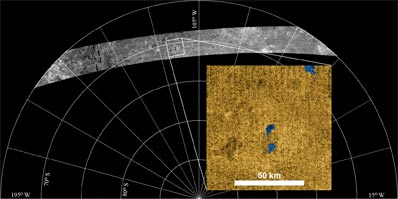
The false-color radar mosaic above shows the first lakes clearly identified in the south polar region. The views were acquired during the Titan flyby of October 2, 2007 by the Cassini probe. Source: NASA, JPL, USGS.
In addition to the discovery of lakes in Titan's south polar region, astronomers have reached a new step by directly observing rain on Titan for the first time. They have unveiled persistent morning drizzle over Titan's major continent, Xanadu, by using near-infrared images. Xanadu is a continent, appearing bright and reflective in Titan's infrared images. The authors of the work are astronomers at the University of California, Berkeley. The finding was made possible thanks to the near-infrared images from Hawaii's W.M. Keck Observatory and Chile's Very Large Telescope. A nearly global cloud cover at high elevations is revealed as well as a wide-spread and persistent morning drizzle of methane over the western foothills of Titan's major continent, Xanadu.
Most images show that liquid methane clouds and drizzle appear at the morning edge of Titan, the arc of the moon that has just rotated into the light of the sun. Imke de Pater, UC Berkeley professor of astronomy explained: "Titan's topography could be causing this drizzle...The rain could be caused by processes similar to those on Earth: Moisture laden clouds pushed upslope by winds condense to form a coastal rain." Xanadu seems to be the only place where the drizzle appears. And this drizzle does not always appear in the same spot. It appears to be a morning drizzle because it seems to dissipate after about 10:30 a.m. local time which represents three Earth days after sunrise ( given that Titan takes 16 Earth days to rotate once ). Depending on conditions, the drizzle could hit the ground or turn into a ground mist.
That's what suggests Lead author Mate Adamkovics, a UC Berkeley research astronomer who added:" Maybe only Xanadu has misty mornings." In collaboration with de Pater and other colleagues in UC Berkeley's Center for Integrative Planetary Studies, he reports the observations in the October 11 issue of Science Express, an online version of the journal Science.
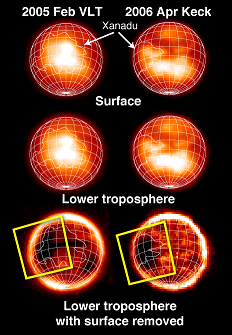
The mosaic above, with data from the Keck and VLT telescopes, shows Titan at different wavelengths to reveal surface and atmospheric features. The reflective continent of Xanadu can be seen. The two Titan views in the lower part of the mosaic reveal a dark patch in the lower troposphere over Xanadu. This dark patch is interpreted as drizzle. Source: UC Berkeley.
We know, now, that Titan's atmosphere is composed of multiple haze layers, notably a hydrocarbon haze extending as high as 500 kilometers, becoming thinner with height. The south pole stores more haze than elsewhere, with a hood of haze at an altitude between 30 and 50 kilometers. We have now direct evidence for rain. The hypothesis that cryovolcanism is a main source for the origin of lakes in the poles must be reconsidered. The authors noted:" Widespread and persistent drizzle may be the dominant mechanism for returning methane to the surface from the atmosphere and closing the methane cycle."
The first cloud views were captured in 2001 by de Pater's group and colleagues at Caltech using the Keck II telescope with adaptive optics. The frozen methane clouds evolved at an elevation of roughly 30 kilometers around Titan's south pole. More recently, isolated ethane clouds have been observed at the north pole by the Cassini orbiter, while both Cassini and Keck photographed methane clouds scattered at mid-southern latitudes. The Huygens probe, in January 2005, during its atmospheric plunge, provided evidence for frozen methane clouds between 25 and 30 km altitude as well as liquid methane clouds with possible drizzle between 15 and 25 km high.
Adamkovics insisted that the new images reveal a widespread cloud cover of frozen methane at a height of 25 to 35 kilometers which is consistent with Huygens' measurements, plus liquid methane clouds in the tropopause beneath 20 km with rain at lower altitudes. He advanced:" The stratiform clouds we see are like cirrus clouds on Earth..."One difference is that the methane droplets are predicted to be at least millimeter-sized on Titan, as opposed to micron-sized in terrestrial clouds, a thousand times smaller. Since the clouds have about the same moisture content as Earth's clouds, this means the droplets on Titan are much more spread out and have a lower density in the atmosphere, which makes the clouds 'subvisible' and thus hard to detect."
Views at different infrared wavelengths allow astronomers to identify clouds at different altitudes thanks to the methane absorption profile. Adamkovics used a new instrument on the European Southern Observatory's VLT, the SINFONI or Spectrograph for INtegral Field Observations in the Near Infrared, to identify the first evidence of widespread, cirrus-like clouds and methane drizzle on February 28, 2005. Sharper views and spectra acquired on April 17, 2006, by the OH-Suppressing Infra-Red Imaging Spectrograph ( OSIRIS ) on Keck II confirmed the clouds. The instruments measure spectra of light at different altitudes. Hence, by substracting light reflected from the surface from the light reflected by the clouds, the researchers were able to obtain views of the clouds covering the entire moon.
Adamkovics explained: " Once we saw this in both data sets, we altered our radiative transfer models for Titan and recognized that the only way to explain the data was if there was liquid or solid methane in the atmosphere." He concluded:" This is a big step in helping us understand the extent to which solid clouds and liquids are spread throughout Titan's atmosphere."
Some scientists regard Titan's icy climate as a tropical climate. Ray Pierrehumbert, the Louis Block Professor in Geophysical Sciences at Chicago and Jonathan Mitchell who recently completed his Ph.D. in Astronomy and Astrophysics at Chicago have been comparing observations of Titan collected by the Cassini spacecraft and the Hubble Space Telescope with their own computer simulations of the moon's atmosphere. Pierrehumbert pointed out:" The ironic thing on Titan is that although it's much colder than Earth, it actually acts like a super-hot Earth rather than a snowball Earth, because at Titan temperatures, methane is more volatile than water vapor is at Earth temperatures."
Unlike Earth's tropical weather systems which extend only to plus or minus 30 degrees of latitude from the equator, on Titan, which rotates only once every 16 days, the tropical weather system extends to the entire moon. Titan's atmosphere generates an updraft where surface winds converge. This updraft raises evaporated methane up to cooler temperatures and lower pressures, where much of it condenses and forms clouds. Jonathan Mitchell advanced:" This is a well-known feature on Earth called an ITCZ, the inter-tropical convergence zone." On Earth, the ITCZ is confined, to a large extent, by the oceans to the lowest latitudes. But as there is no ocean in the low latitudes of Titan, the ITCZ in Mitchell's computer simulations wanders in latitude nearly from one pole to the other. The clouds should also follow the ITCZ. The southern hemisphere currently in the summer season concentrates the clouds.
Jonathan Mitchell pointed out:" There should be a very large seasonality in these cloud features...Cassini and other instruments might be able to tell us about that in the next seven to 10 years or so, as the seasons progress." Will the low latitudes, dominated by dunes of ice or tar, remain dry ?
- To get further information on that news, go to: http://www.spaceflightnow.com/news/n0710/11titanlakes, http://www.astrobio.net/news/modules.php?op=modload&name=News&file=article&sid=2490 and http://www.saturndaily.com/reports/Titan_Icy_Climate_Mimics_Earth_Tropics_999.html
June 5, 2007: Tholin Forming Higher than Previously Thought in Titan's Atmosphere
New data reveal that complex hydrocarbon molecules known as tholins form higher than 1000 km altitude in Titan's atmosphere. We previously thought it formed at altitudes no higher than hundreds of km high. It's a new clue about how complex hydrocarbon molecules take shape in the atmosphere of Titan and where they are generated. The action of ultra-violet light plays a key role in the process of carbon-made molecule formation. The finding upon the origin of Tholins was made thanks to three particle spectrometers aboard the Cassini spacecraft.
The observations are presented by scientists at Southwest Research Institute ( SwRI ), the University of Kansas, University College London and the University of Texas at San Antonio in the May 11 issue of Science. The title of the paper is " The Process of Tholin Formation in Titan's Upper Atmosphere."
What are tholins ? Dr. Hunter Waite, an Institute scientist in SwRI's Space Science and Engineering Division, and leader of Cassini's Ion Neutral Mass Spectrometer ( INMS ) team, points out: " Tholins are very large, complex organic molecules thought to include chemical precursors to life." He adds:" Understanding how they form could provide valuable insight into the origin of life in the solar system."
The atmosphere of Titan is dominated by nitrogen and methane. But the INMS detected other significant compounds and notably benzene, a critical component in the formation of aromatic hydrocarbon compounds. Two other Cassini sensors that are part of the Cassini Plasma Spectrometer ( CAPS ) investigation, the Ion Beam Spectrometer ( IBS ) and Electron Spectrometer ( ELS ) measured large positive and negative ions. On that point, Dr. David Young of the SwRI and leader of the CAPS investigation, insists:" The negative ions were a complete surprise. This suggests they may play an unexpected role in making tholins from carbon-nitrogen precursors."
Dr. Andrew Coates, a researcher at the Mullard Space Science Laboratory, University College London said: " An additional surprising point is the large numbers of negative ions we see during Cassini's lowest flybys above the surface." He added:" This newly discovered, and important, population represents a highly significant proportion of the whole ionosphere at these locations."
Hunter Waite noted:" Our analysis suggests that the organic compounds are formed through ion-neutral chemical processes, which then give rise to the complex negative ions found by the ELS."
While complex hydrocarbon molecules are forming in Titan's upper atmosphere, a sea is progressively unveiled by the radar mapper in Titan's north polar region. The sea likely consists of hydrocarbon molecules, methane, ethane or a mixture of these compounds. The sea is probably a "major player" in fueling the giant cyclone or hurricane identified around the north pole.
Moreover, astronomers are puzzled by the relative scarcity of craters on the surface of Titan. Ralph Lorenz of the Johns Hopkins University Applied Physics Laboratory pointed out:" With radar having examined about 10 percent of Titan's surface, we have only three definite craters, and perhaps a half-dozen probables." Three craters are confirmed: Menrva ( 273 miles or 440 km ), Sinlap ( 50 miles or 80 km ) and Ksa ( 17 miles or 28 km ). The dense and deep atmosphere acts as a shield for the small-sized space rocks which burn up before they reach the surface. Lorenz added:" We've seen three craters on 10 percent of the surface, so we will probably find another 10 to 30. Maybe there are 30-100 in total, although we will need a follow-on mission to Titan to find and document them all." The relative scarcity of impact craters might be linked to tectonic movements, sand dunes, cryovolcanism or fluids ( fluvial activity, rain...). The radar views show that Ksa seems to have a very absorbing surface since it appears very dark. That implies that the surface is very smooth.
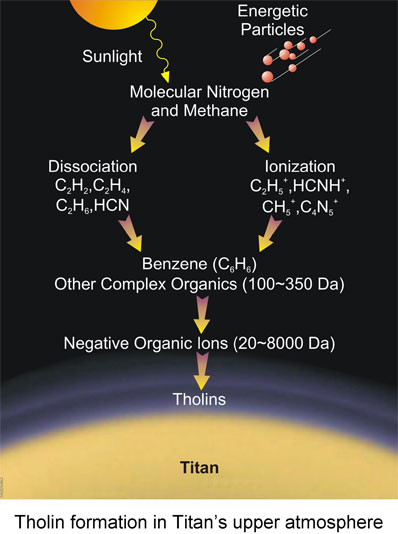
Credit: Southwest Research Institute
- To get further information on that news, go to: http://www.spaceflightnow.com/cassini/070510tholin.html
March 21, 2007: New Cassini Images Reveal the First Sea Ever in Titan's Northern Latitudes
The Titan flyby of February 22, 2007 has been fruitful. An infrared view of Titan's north polar region reveals what appears to be the largest body of liquid ever found on Titan. The irregular dark patch stretches for about 1,100 kilometers ( 680 miles ) in the image, down to 55 degrees north latitude. This extent is likely filled with methane, ethane or a mixture of hydrocarbon molecules. Due to its size, we can call it a sea. It is roughly the same size as the Caspian Sea on Earth.
The radar strip obtained during the Cassini flyby of February 22, 2007 intersects this sea in its northern edges. One can observe that it takes the shape of a bay containing a big island beyond which the surface appears uniformly dark. That reinforces the idea that this extent is filled with a liquid. The sea is likely shallow in its northern edges while it is deeper as we advance through the sea. Further radar passes will be needed to reinforce this hypothesis.
Titan's north pole is covered by a myriad of lakes and rivers. And two bodies of liquid are sufficiently large to be regarded as seas. The first one is about as big as the Caspian Sea. The second one on its right is about the size of Lake Superior.
Dr. Jonathan Lunine, Cassini interdisciplinary scientist at the University of Arizona, Tucson pointed out: "We've long hypothesized about oceans on Titan and now with multiple instruments we have a first indication of seas that dwarf the lakes seen previously."
It's very likely that Titan's south pole is blanketed with lakes and seas. In 2005, an infrared image of Titan's south pole had revealed a pleiad of small dark patches as well as a big uniform dark patch with a kidney shape, about 400 km large. This kidney shape is now called "Ontario Lacus".
Titan's north pole is likely dominated by thunderstorms and heavy rains or snow falls as the latest findings suggest: a giant hurricane-like cloud formation, about half the size of the United-States and engulfing Titan's north pole up to a latitude of around 60 degrees north latitude, has been spotted few weeks ago. The south pole has also shown some large cloud formations, rapidly dissipating.
The meteorology at the poles seems to be very active with a methane or ethane cycle. Currently, the meteorology at lower latitudes seems to be devoid of cumulo-nimbus or large cloud formations: only cirrus-like clouds at mid-latitudes have been identified. For instance, the infrared view of Titan's north pole, taken on February 25, 2007 shows two cloud streaks at about 60 degrees north latitude.
Why are the bodies of liquid and cloud masses located in Titan's high latitudes? It is still a mystery. Some scientists note that it is currently winter in the northern hemisphere. The mean temperature is expected to be lower at the north pole compared to the equatorial regions. Therefore, methane and ethane gases are likely to condense more easily. As winter turns to spring, scientists anticipate that the lakes and the clouds will migrate towards lower latitudes.
Titan is probably marked by seasonal changes: its atmosphere is deeper and denser than that of planet Earth and its obliquity ( inclination of the rotation axis to the orbital plane ) is quite high ( 26 degrees compared to 23.4 degrees for the Earth ). We must keep in mind these parameters which are likely to have a significant impact on the weather dynamics. The presence of clouds at the poles and especially in Titan's north pole may be linked to "Hadley Cell" phenomena.
If the seas observed in Titan's north pole are persistent over time, we can wonder whether an alien life is able to emerge and develop in a solvent like methane, ethane or other hydrocarbon molecules. As life forms on Earth, methane and ethane are based on carbon. Under the action of ultraviolet radiations, the hydrocarbon molecules are likely to recombine and form more complex molecules and so on. The presence of a permanent lake or sea is likely to accelerate the chemical reactions of complex molecules. Marc Lafferre insists that the question about an exobiology in Titan wetlands deserves our whole attention. Anyway, this lifeform would'nt be based on water as water is not liquid in Titan's frigid conditions. It would rather be based on methane and ethane.
Scientists are now starting to prepare a mission in Titan's arctic region, a mission that would involve a balloon and new technologies. But we'll have to wait for at least 15 years. Team members are re-pointing Cassini's radar instrument during a May flyby so it can pass directly over the dark areas imaged by the cameras in Titan's north polar region.
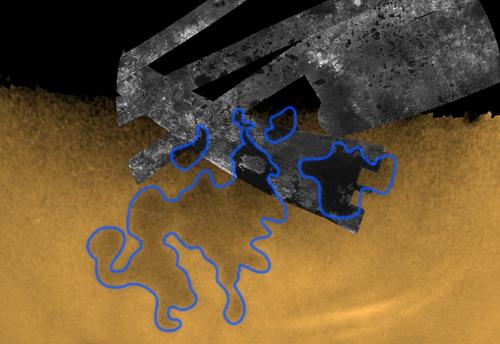
This composite view of Titan's northern latitudes is based on radar images, infrared views and near-natural views. One can see the largest body of liquid ever found on Titan, roughly as large as the Caspian Sea. The upper part of this sea has been imaged by the rader mapper during the flyby of February 22, 2007.
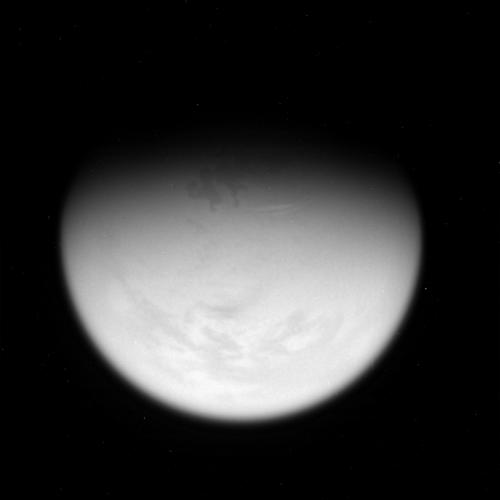
This infrared view of Titan's northern latitudes, above, taken on February 25, 2007 shows a dark patch which appears to be the first sea ever found on Titan. Two cloud streaks are clearly visible at about 60 degrees north latitude.
- To get further information on that news, go to: http://saturn.jpl.nasa.gov/news/press-release-details.cfm?newsID=731
February 10, 2007: Hurricane-Like-Cloud Formation Spotted in Titan's North Pole and Strong Jet Streams at Mid-Latitudes
A new infrared image of Titan taken on December 29, 2006 by Cassini's Visual and Infrared Mapping Spectrometer reveals a huge cloud formation covering Titan's north pole. It had never been imaged in such detail before. The cloud had been hidden by winter's shadow, but now, as winter turns to spring, this cloud has come into view. It extends down to 60 degrees north latitude, is around 2,400 kilometers ( 1,490 miles ) in diameter and blankets nearly the entire north pole of Titan. In other words, the mammoth cloud is half the size of the United States. The cloud formation has also been imaged during the flyby of January 13, 2007 but the observing conditions were slightly less favorable than in December.
Dr. Christophe Sotin of the University of Nantes, France, a member of the visual and infrared mapping spectrometer team and distinguished visiting scientist at NASA's Jet Propulsion Laboratory, Pasadena, California pointed out:"We knew this cloud had to be there but were amazed at its size ans structure". He added:" This cloud system may be a key element in the global formation of organics and their interaction with the surface."
Another scientist of the University of Nantes who is also working with the Cassini VIMS, Dr. Stephane Le Mouelic, said: "With 16 more flybys to come this year, we should have the opportunity to monitor the evolution of this cloud system over time."
Interesting phenomena appear to be evolving in Titan's north pole. Titan's radar images have unveiled a multitude of lakes and rivers above 70 degrees north latitude. We've identified completely-filled lakes, partly-filled lakes and also dried-up lakes. Dried-up lakes appear to be located at lower latitudes. The mammoth polar cloud is likely closely linked to the lakes. One can draw a parallel between the Earth meteorology and the Titan meteorology: since the cloud formation observed, consists of ethane, methane and other organics, we can assume that there is a methane cycle or methane-ologic cycle on Titan that we can compare to the hydrological cycle on Earth. Some lakes have evaporated contributing to this "cloud whirlpool". How often does it rain? And does it rain methane, ethane or a mixture of both molecules? Are there flashes of lightning, thunderstorms? what is the destiny of this cloud? Is this hydrocarbon concentration related to the small amount of sunlight received?
The data gathered thanks notably to ground-based telescopes reveal that the cloud formation comes and goes with the seasons. A season on Titan lasts roughly seven Earth years. On the basis of the global circulation models, it appears that such cloud activity can last around 25 Earth years before almost vanishing for four to five years, and then appearing again for 25 years. The VIMS images of Titan's south pole have shown how fast the cloud system observed had dissipated.
The models indicate that the cloud should remain relatively stable for several years. As the seasons change, scientists predict that the clouds and lakes are likely to move from the north pole to the south pole. Currently, the south pole is not devoid of lakes and clouds as the infrared images have shown. A large kidney-shaped dark patch, hundreds of km wide had been spotted as well as a large cloud formation.
A pair of rare celestial alignments between Titan and 2 stars ( just seven and a half hours apart ) occured on 14 November 2003, allowed to deduce that Titan's atmosphere was flattened at the north pole. Bruno Sicardy, Observatoire de Paris, France, and his team analysed the shape of the flash in the middle of the occultation event. At the time of the alignment, Titan's south pole was tilted towards the sun. As a result, the amount of solar energy received was higher which warmed the atmosphere there, causing it to rise and move towards the north of the Saturn moon, where the atmosphere cooled and sank towards the surface.
Their analysis also helped validate the atmospheric model used to design the entry trajectory for ESA's Huygens probe. They also inferred a fast moving, high altitude wind ( above 200 kilometres ) which was blowing around Titan at 50 degrees north latitude. It was estimated to be moving at 200 metres per second ( 720 kilometres per hour ) and would turn around the planet in less than one terrestrial day. Sicardy pointed out:"It is like the jet stream on Earth". He added:"Furthermore, we told the Huygens team to expect some bumps near 510 km altitude, due to a narrow and sudden temperature variation." Jean-Pierre Lebreton, Huygens project scientist confirmed:"A temperature inversion was indeed detected by the accelerometers during entry at this very altitude."
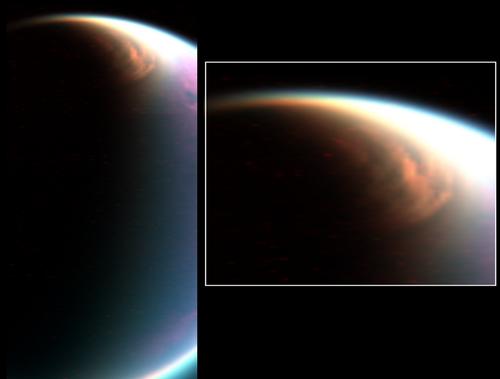
This VIMS image was taken during the flyby of December 29, 2006. It unveils a huge cloud formation engulfing Titan's north pole, where it is currently winter. Is it chronicly present or will it progressively dissipate as winter turns to spring?
- To get further information on that news, go to: http://www.spaceflightnow.com/cassini/070201titancloud.html
January 5, 2007: Liquid Lakes Confirmed and a Mountain Range Spotted
Scientists report in Nature, this week convincing evidence that the radar-dark patches observed in Titan's northern latitudes are the signature of lakes. A detailed analysis of the radar images taken during the flyby of July 22, 2006 near 80 degrees north, 35 degrees west, leads to the conclusion that the dark patches are partly or fully filled with a liquid, likely methane or ethane.
The radar-dark patches are interpreted as lakes, notably because they have the radar signature of terrestrial lakes. They present a very low reflectivity, generally uniform. They are sometimes connected to dark channels, revealing drainage channels in topographic depressions. Clear rims or shorelines between dark and bright areas can be identified. More than 75 radar-dark patches were seen, ranging from 3 kilometers ( 1.8 miles ) to more than 70 kilometers ( 43 miles ) across. Some lakes are apparently partly dry. They may have partly evaporated at some point in the past. Approximately 15 of the dark patches seem filled with a liquid. Several kinds of lakes can be seen. Some lakes have a nest-like nature. A lake, for instance, seems to be located in a volcanic calderas, giving the impression that it lies in a collapsed dome with wide edges. Some lakes have steep margins or distinct edges. Some lakes have diffuse boundaries. They may have partly dried up. One observes a gradual decrease in radar brightness towards the center of the lake. Some radar images have also revealed dark branching networks, indicating the presence of a fluid with eastward streams. Parallels are made with terrestrial lakes like Clearwater Lakes in Canada, Crater Lake in Oregon or Lake Powell. Small islands are sometimes spotted. It's unlikely that it represents "floating icebergs" because methane ice is denser than liquid methane.
At the end of the day, it's hard to believe that those dark patches are not a characteristic of a liquid. The dark feature implies a smooth and absorbing surface . If it's not liquid methane, it's an organic material , a low density deposit that is darker than any observed elsewhere on Titan.
The lakes turn out to be concentrated in Titan's northern latitudes, currently in the winter season. It is expected to be a little colder than in lower latitudes with less sunlight. As a result, methane molecules are likely to condense more easily, form clouds and fall as rain. A recent report revealed that Titan's north pole was surrounded by a blanket of ethane clouds. Probably that there is a close link between those clouds and the lakes. It tends to indicate that the lakes are generated via meteorology rather than volcanism. A big question is whether there is a subsurface layer saturated with liquid methane.
As Titan's seasons progress over the 29-year cycle of Saturn's orbit around the sun, lakes in the winter hemisphere should expand by steady methane rain, while summer hemisphere lakes shrink or dry up entirely.
One of the main enigmas scientists are facing is why methane is still present in Titan's atmosphere. The lifespan of a methane molecule is several tens of millions of years. The methanosphere should have been broken up by sunlight. Something must be continuously replenishing it . Probably cryovolcanoes!
Titan was thought to be relatively flat due to its icy surface and its low density compounds but a new discovery suggests this is not really the case. A large mountain range has been spotted just south of Titan's equator during the flyby of October 25, 2006. The range is about 150 kilometers long ( 93 miles ), 30 kilometers ( 19 miles ) wide and about 1.5 kilometers ( nearly a mile ) high. Deposits of bright, white material, which may be methane "snow" or exposures of some other organic material, lie at the top of the mountain ridges.
Dr Bob Brown, team leader of the Cassini Visual and Infrared Mapping spectrometer at the University of Arizona, Tucson pointed out:" We see a massive mountain range that kind of reminds me of the Sierra Nevada mountains in the western United States. This mountain range is continuous and is nearly 100 miles long."
Dr Larry Soderblom, Cassini interdisciplinary scientist at the U.S.Geological Survey, Flagstaff, Arizona noted:" These mountains are probably as hard as rock, made of icy materials, and are coated with different layers of organics." He added:" There seem to be layers and layers of various coats of organic 'paint' on top of each other on these mountain tops, almost like a painter laying the background on a canvas. Some of this organic gunk falls out of the atmosphere as rain , dust, or smog onto the valley floors and mountain tops , which are coated with dark spots that appear to be brushed, washed, scoured and moved around the surface."
The mountain range is probably linked to a tectonic activity. The mountain line is likely the outcome of a collision between tectonic plates or an upwelling of material from below to fill the gaps opened when tectonic plates pull apart, similar to the way mid-ocean ridges are formed on Earth.
Scientists managed to determine the size, the characteristics of the mountain range thanks to the combination of infrared images and radar images. The infrared images revealed the shadows of the mountains making them deduce that the peak was about a mile high. The radar data unveiled the shape of the mountain range.
Some scientists postulate that those icy mountains may have emerged following a violent impact that cracked the Titanian crust. Close to the mountain range, a huge semicircular feature is visible. It's most likely an ancient impact basin. In other words, a meteorite must have hit the area generating tectonic movements and mountains.
Robert Brown said:" We think it works like Earth's mid-ocean ridges with plates pulling apart and magma welling up in the middle." The feature resembling the letter "H", might be a rift valley created by the same event. The cryomagma and cryolava were probably a mixture of water and ammonia.
Some scientists don't favour the hypothesis of the impact basin, rather the volcano hypothesis. That's what Dr Rosaly Lopes , Cassini radar team member at NASA's Jet Propulsion Laboratory, Pasadena, California, thinks. She said:" The evidence is mounting that the circular feature is a volcano. With radar data alone, we identified it as a possible volcano, but the combination of radar and infrared makes it much clearer."
The Cassini flyby also revealed long clouds, probably made of methane. Is it expelled from an ice volcano? Scientists think it is more likely generated via a meteorological phenomenon and thanks to the height of the mountain range. A constant wind blows eastward and as it rises up over the mountains, it should cool down, forcing methane droplets to condense out of the nitrogen atmosphere, forming clouds.
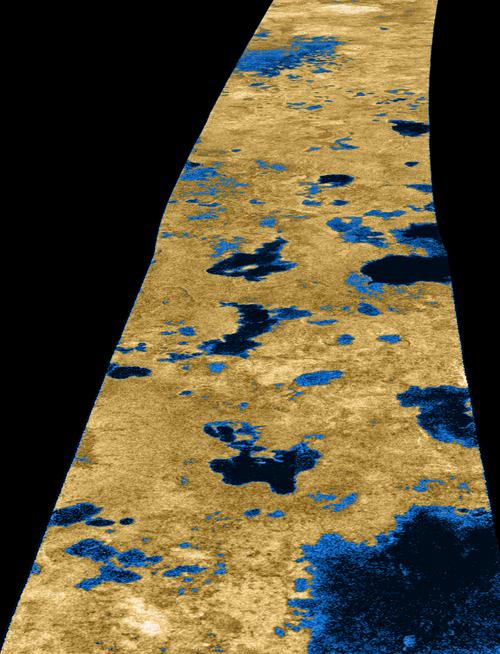
This false color radar image was generated using radar data taken by the Cassini probe during the flyby of July 22, 2006. The image is centered near 80 degrees north latitude, 35 degrees west longitude and it is about 140 kilometers ( 84 miles ) across. It appeared in the Journal "Nature" on January 4, 2007. The blue and dark patches likely represent lakes.
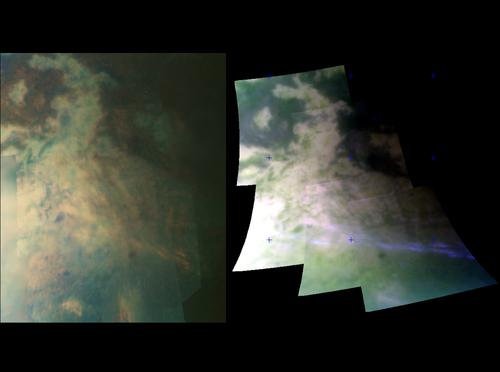
This image set obtained during the flyby of October 25, 2006 reveals an area with mountain ranges and shows a band of bright clouds. Image source: NASA, JPL
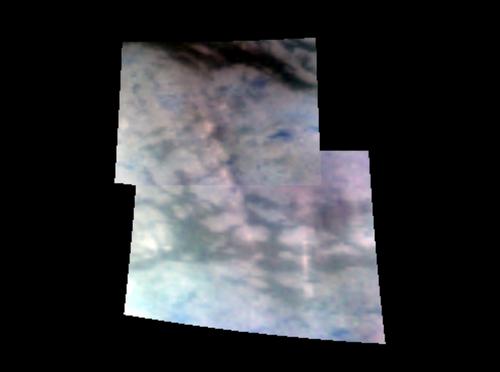
This infrared image taken during the flyby of October 25, 2006 shows a massive mountain range running just south of Titan's equator. Image source: NASA, JPL
- To get further information on that
news, go to: http://saturn.jpl.nasa.gov/news/features/feature20070103.cfm